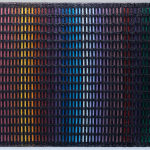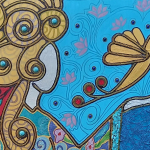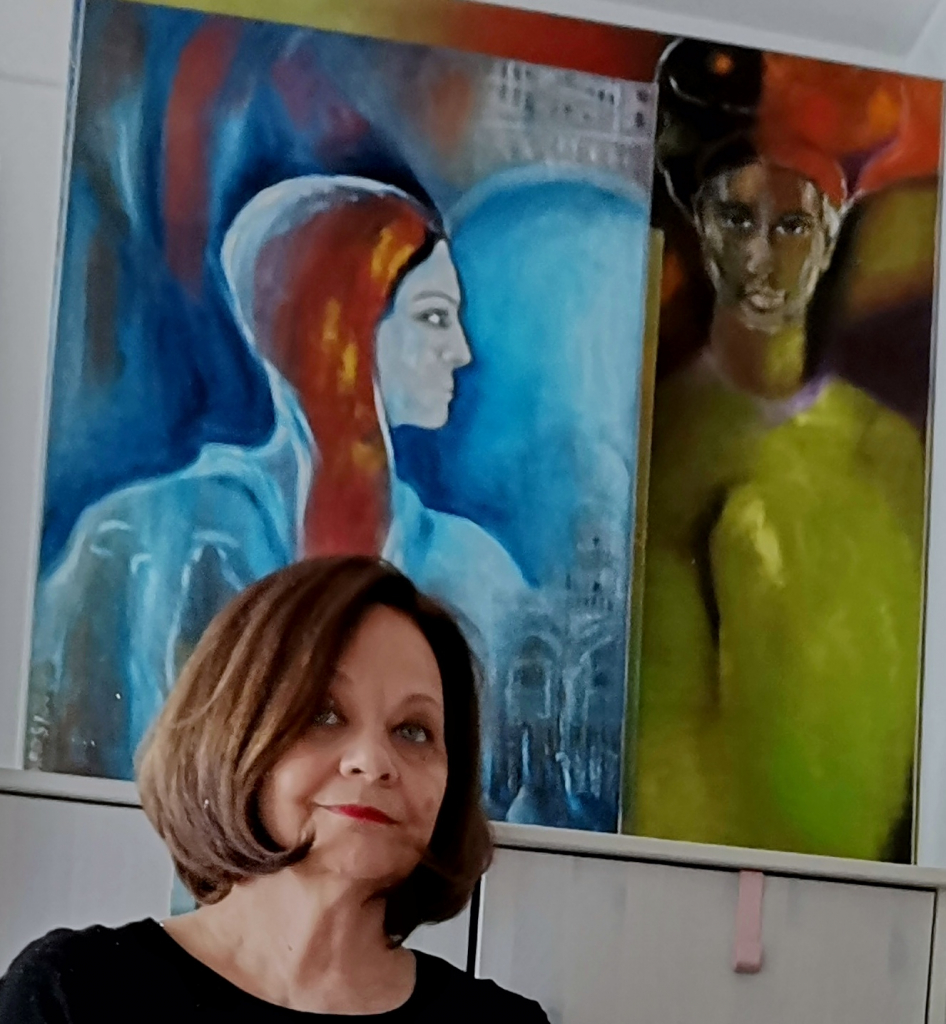
Attratta dal disegno, dalla musica e dallo sport fin da bambina, sceglie di inseguire un cammino professionale legato alla sua natura creativa ma non propriamente affine alla pittura, che continua a sognare di praticare per tutto il corso della sua vita lavorativa. Conseguito il diploma di artista grafica presso la Scuola Superiore Tecnica Federale di Linz, in Austria, comincia presto a entrare nel campo pubblicitario giungendo a collaborare con le principali aziende di moda per occhiali come Dior, Carrera e Porsche; l’impegno intenso le ha sempre impedito di praticare l’arte nel modo più tradizionale, cioè tra tele e pennelli, cullando quel suo sogno fino al giorno in cui matura gli anni necessari per andare in pensione dedicandosi, da quel momento in poi, a perfezionare la sua tecnica e a creare un suo personale linguaggio pittorico. I molti anni come grafica pubblicitaria le forniscono una solida base da cui partire per elaborare le sue opere, inizialmente dunque basate sulla tecnica mista dove la parte grafica veniva poi modificata e arricchita dalle pennellate; successivamente passa all’olio su tela assumendo uno stile attualmente espressionista, preceduto da un periodo più legato al Neosimbolismo, perché dipingere per lei significa manifestare le proprie sensazioni, le narrazioni e le intuizioni ricevute e percepite, anche durante i viaggi effettuati soprattutto in Africa e in India. L’approccio empatico di Hannelore Diaw-Roth è evidente, tanto quanto la sensibilità attraverso la quale scruta ciò che la circonda per poi manifestarlo in maniera diretta e al tempo stesso suggestiva perché sembra sempre soffermarsi sulle sfumature, anche quando l’argomento trattato è forte, deciso; scoprire e conoscere paesi diversi dal proprio, osservare modi di vita differenti, approcci alle circostanze completamente difformi e a volte persino divergenti dal mondo in cui si è cresciuti, genera un’apertura maggiore nei confronti delle molteplici sensibilità permettendo di esporre la propria opinione senza gridarla o imporla bensì semplicemente illustrandola. La morbidezza espressiva e l’inclusività, estesa anche al modo di essere di ciascuno, diventano così caratteristiche identificative delle tele della Diaw-Roth che spesso affida agli uomini e alle donne incontrare nei mondi lontani che ha visitato, l’interpretazione di un suo pensiero, di una sua considerazione sulle tematiche attuali che non manca mai di esprimere nelle sue opere, quasi a sottolineare che alcune problematiche, alcuni disagi appartengono all’essere umano nella sua interezza, senza distinzione di razza o di religione. In Stop War
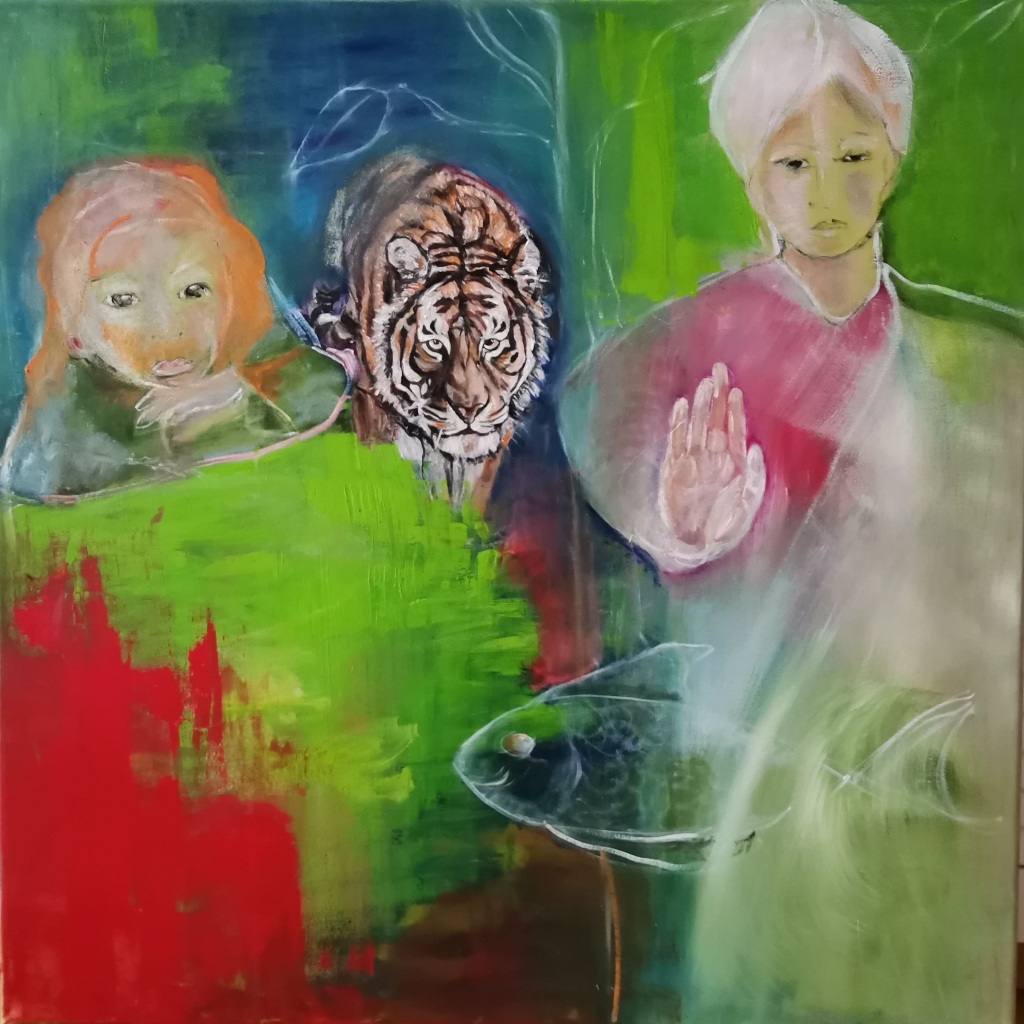
l’artista colloca le figure protagoniste in uno spazio temporale non riconoscibile, perché non è importante il luogo da cui si leva la richiesta di pace, essa appartiene al mondo, a tutte le persone che hanno bisogno di veder smettere conflitti inutili che creano solo sofferenza e dolore distruggendo anche gli equilibri naturali degli scenari dei conflitti. La donna, raccontata in modo quasi evanescente, con un gesto della sua mano esprime ciò che la bambina accanto a sé e gli animali non possono dire, eppure tutti corrono lo stesso rischio di estinzione, intesa come fine della vita, a causa degli interessi di pochi. Il suo tratto delicato ed empatico emerge ancor più nell’opera Lebensweg (Modo di vivere),
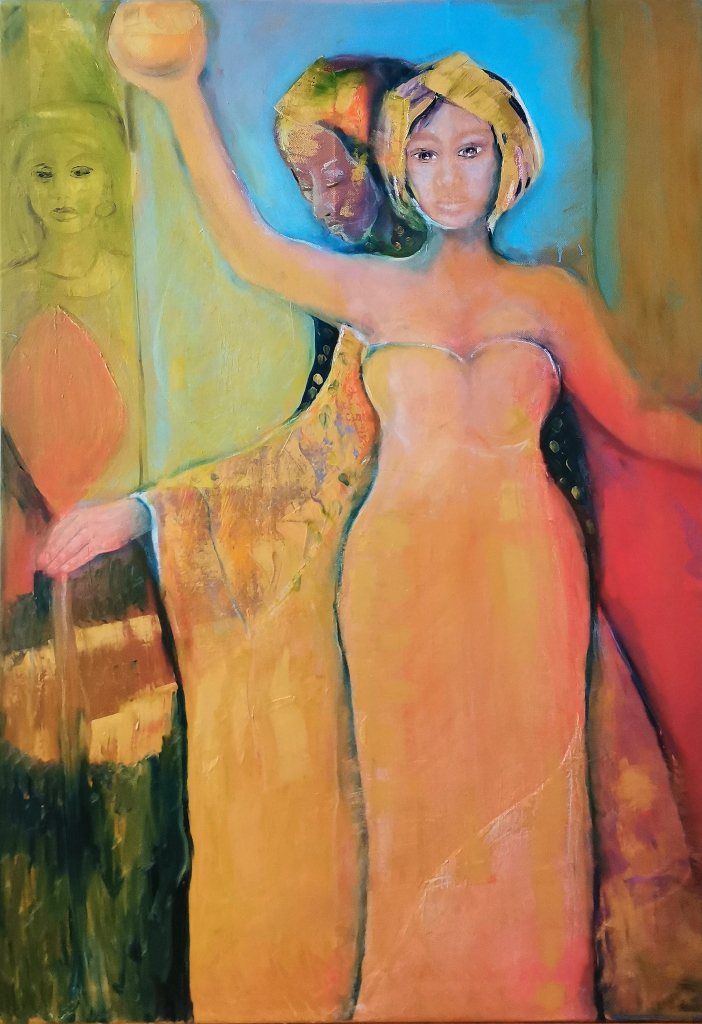
dove Hannelore Diaw-Roth immortala una ragazza africana, con la sua sinuosità e il suo orgoglio anche nello svolgere compiti semplici e apparentemente insignificanti, che però hanno una loro importante funzione nella cultura del suo popolo, insieme a una donna islamica con il suo chador appena dietro di lei, con il capo basso e lo sguardo rivolto verso terra, come se in qualche modo svelasse l’abitudine a nascondere se stessa, a essere messa in secondo piano; e infine in fondo sul lato sinistro si intravede una donna europea, forse la stessa artista che sembra osservare da lontano quel mondo tanto differente dal proprio quanto altrettanto reale. L’invito della Diaw-Roth è quello di scoprire e comprendere senza giudicare perché in fondo ogni cultura ha i suoi lati positivi e i suoi lati negativi e non è possibile né giusto pensare che una prevalga o sia migliore di un’altra. Andiamo ora a scoprire di più di questa brava artista.
Hannelore, lei ha lavorato per molti anni nel campo della grafica pubblicitaria, collaborando per grandi marchi di moda. Quanto ha influito questa esperienza professionale nel suo stile pittorico? Come è avvenuto il passaggio verso l’Espressionismo?
In qualità di grafico dovevo lavorare in modo molto preciso, accurato e quasi sempre sotto pressione. Questo si riflette nei miei primi dipinti a olio. Precisione, forma, disegno e combinazioni di colori. Solo in seguito sono diventata più libera nell’espressione e ho sperimentato anche la spatola per esprimermi spontaneamente in diverse combinazioni di colori. Emotivo, a volte molto sensibile, multistrato e dimensionale. Affondo meditativamente in mondi e visioni da sogno.
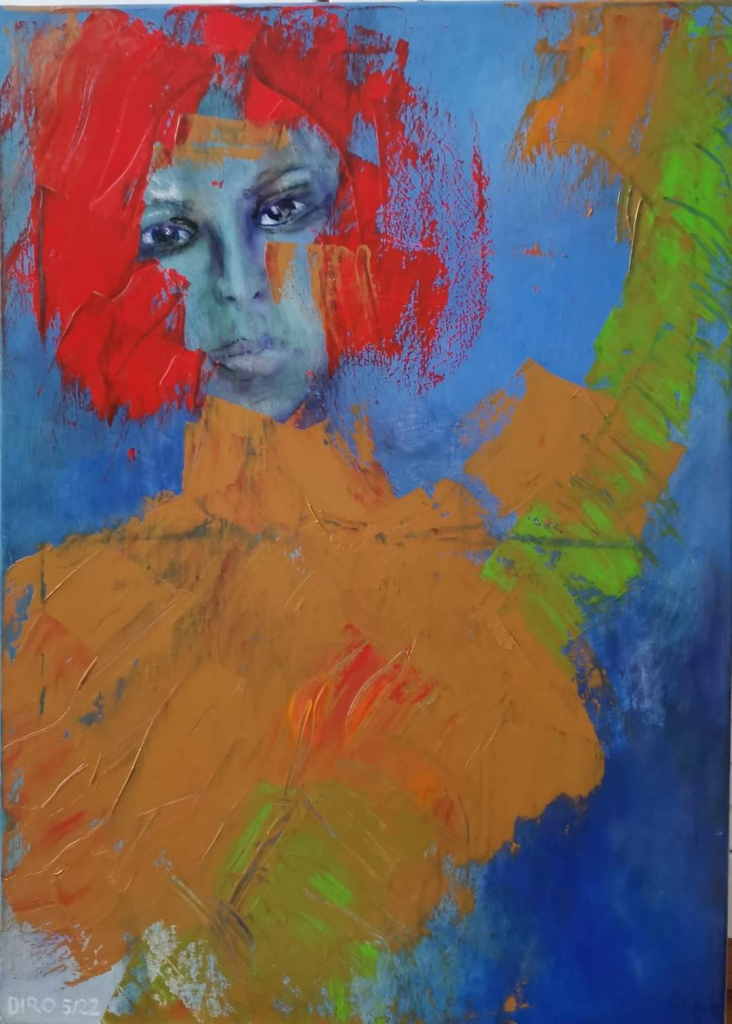
I suoi viaggi hanno contribuito a metterla in contatto con culture diverse e lontane, è possibile dire che la sua pittura sia una sinergia e al tempo stesso una contaminazione tra queste culture? Cosa ha appreso e preso dall’arte africana e cosa da quella indiana?
Il fascino dell’arte africana è catturato dai colori e dai simboli forti e luminosi della terra. Potenza elementare, terrosità portata direttamente al punto senza molte sfumature. Spontaneo e tratto dalla vita, si tratta di un confronto diretto con la rappresentazione e in contrasto con la pittura indiana, che è molto sfaccettata, stratificata e per lo più rappresentata da motivi religiosi, ma anche sensuali. Quest’ultima racconta l’uomo in connessione con gli elementi divini, così come l’incarnazione delle tradizioni, dei costumi e delle ideologie della cultura indiana. Questi due mondi, che non potrebbero essere più diversi, hanno certamente lasciato un’impressione e un’influenza su di me.
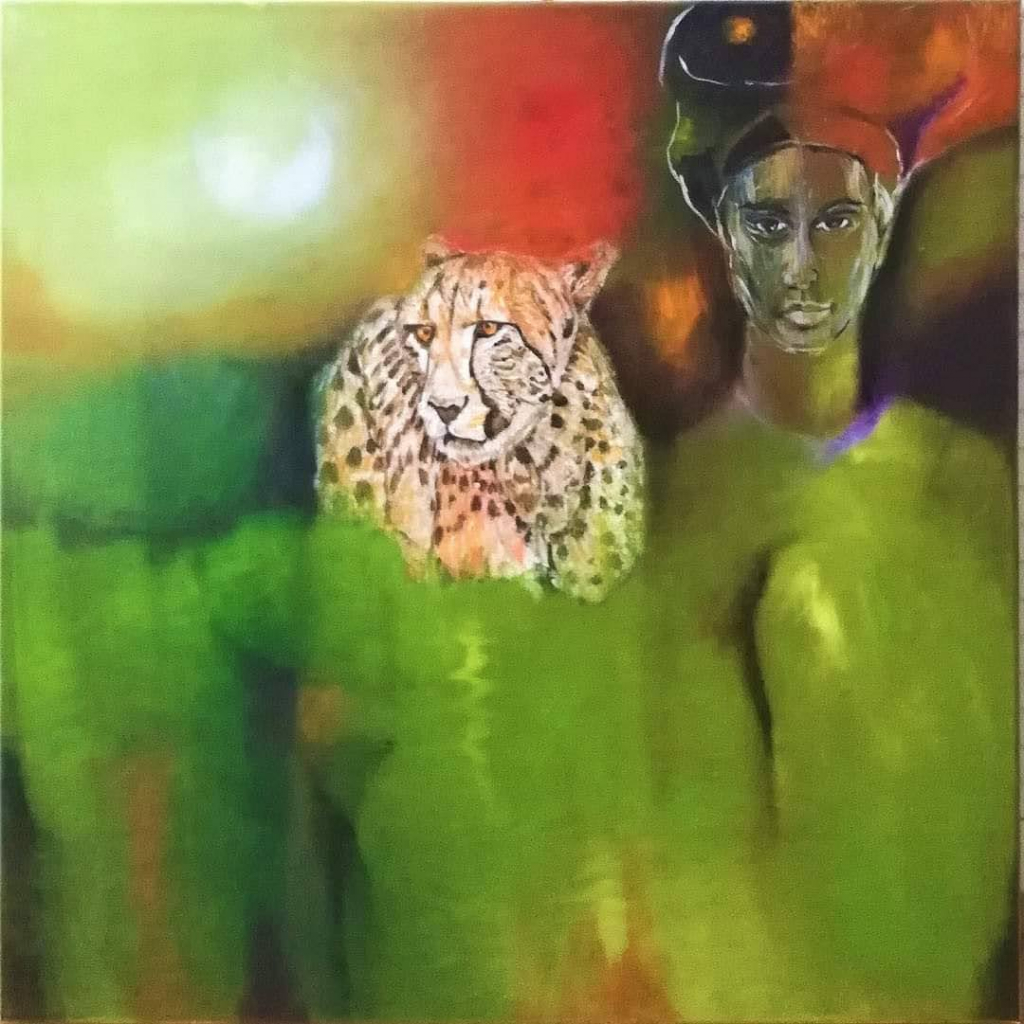
Lei ha cominciato a dedicarsi alla pittura solo dopo aver terminato il suo percorso lavorativo. Crede che la distanza dal suo sogno sia stata necessaria per far maturare in lei il suo impulso espressivo? Quanto è importante nella società odierna mantenere vivi i sogni e poi scegliere di realizzarli?
Le inclinazioni e i talenti si manifestano già nell’infanzia e vogliono essere vissuti. Prima o poi devono trovare concretezza per arricchire la vita e realizzarsi. Per me la pittura è un’immersione in un altro mondo, una meditazione o anche una rivalutazione della vita vissuta, un confronto con le esperienze, l’osservazione e l’empatia con l’anima umana e animale. La realizzazione del mio sogno d’infanzia, di cui ora posso godere appieno.
Il suo stile attuale è espressionista, anche se morbido e sfumato nel tocco pittorico, a quali grandi maestri del passato si ispira? Quali sono quelli a cui si sente più affine?
Già in gioventù sono stata ispirata dalle grandi opere d’arte di Michelangelo Buonarroti e Leonardo da Vinci, i più grandi geni di tutti i tempi. E poi anche Gustav Klimt, Egon Schiele, Paul Gauguin, solo per citarne alcuni. Non sento di assomigliare a nessuno perché nel tempo ho cercato, e continuo a cercare, di sviluppare uno stile pittorico tutto mio.

Ha al suo attivo la partecipazione a mostre collettive in Europa ed è seguita da un appassionato pubblico di collezionisti, quali sono i suoi prossimi progetti? Dove potranno i lettori vedere le sue opere?
Uno dei miei prossimi progetti è il 200° anniversario di Anton Bruckner, un compositore austriaco del periodo romantico, nonché organista e insegnante di musica, nato ad Ansfelden nel 1824. In occasione del duecentesimo anniversario nel 2024 saranno organizzati molti eventi tra cui sarà organizzata una grande mostra pittorica a cui intendo partecipare con alcuni dipinti.
HANNELORE DIAW-ROTH-CONTATTI
Email: hannelore_diaw@hotmail.com
Sito web: https://hannelore-diaw-roth.jimdosite.com/
Facebook: https://www.facebook.com/profile.php?id=100003273639923
https://www.facebook.com/hanni.diawroth
Instagram: https://www.instagram.com/diawroth/
Marta Lock’s interviews: Hennelore Diaw-Roth, a life as a graphic designer waiting to realise her artistic dream
Attracted by drawing, music and sport since childhood, she chose to pursue a career path related to her creative nature but not really to painting, which she continued to dream of practising throughout her working life. After graduating as a graphic artist at the Federal Technical High School in Linz, Austria, she soon began to work in the field of advertising, collaborating with major glasses fashion such as Dior, Carrera and Porsche. Her intense commitment has always prevented her from practising art in the more traditional way, i.e. between canvases and brushes, cherishing this dream until the day she matures the necessary years to retire, dedicating herself, from then on, to perfecting her technique and creating her own pictorial language. Her many years as an advertising graphic artist provided her with a solid basis from which to develop her artworks, initially based on mixed media where the graphic part was then modified and enriched by the brushstrokes. She then moved on to oil on canvas, assuming a style that is currently expressionist, preceded by a period more closely related to Neo-Symbolism, because painting for her means manifesting her own sensations, narratives and intuitions received and perceived, also during her travels, especially in Africa and India. Hannelore Diaw-Roth’s empathic approach is evident, as is the sensitivity through which she scrutinises her surroundings and then manifests it in a direct and at the same time suggestive manner, because she always seems to dwell on nuances, even when the subject matter is strong, decisive; discovering and getting to know countries other than one’s own, observing different ways of life, approaches to circumstances that are completely different and sometimes even divergent from the world in which one grew up, generates a greater openness to multiple sensitivities, allowing one to express one’s own opinion without shouting it out or imposing it, but simply illustrating it. The softness of expression and inclusiveness, extended to everyone’s way of being, thus become the identifying characteristics of Diaw-Roth’s canvases. She often entrusts the men and women she has met in the distant worlds she has visited with the interpretation of her thoughts, of her consideration of current issues, which she never fails to express in her works, as if to emphasise that certain problems, certain hardships belong to the human being as a whole, without distinction of race or religion. In Stop War, the artist places the protagonist figures in an unrecognisable temporal space, because the place from which the call for peace is raised is not important, it belongs to the world, to all the people who need to see an end to useless conflicts that only create suffering and pain by destroying even the natural balance of conflict scenarios. The woman, narrated in an almost evanescent way, with a gesture of her hand expresses what the little girl beside her and the animals cannot say, yet they all run the same risk of extinction, intended as the end of life, due to the interests of a few. Her delicate and empathic trait emerges even more in the work Lebensweg (Way of life), where Hannelore Diaw-Roth immortalises an African girl, with her sinuousness and pride even in performing simple and apparently insignificant tasks, which nonetheless have their own important function in the culture of her people, together with an Islamic woman with her chador just behind her, her head lowered and her gaze turned towards the ground, as if somehow revealing her habit of hiding herself, of being put in the background; and finally, at the back on the left-hand side, can be glimpsed a European woman, perhaps the artist herself, who seems to be observing from afar that world as different from her own as it is equally real. Diaw-Roth’s invitation is to discover and understand without judging because, after all, every culture has its good and bad sides and it is neither possible nor right to think that one prevails or is better than another. Let us now find out more about this fine artist.
Hannelore, you have worked for many years in the field of advertising graphics, working for large fashion brands. How much did this professional experience influence your painting style? How did the transition to Expressionism come about?
As a graphic artist, I had to work very precisely, accurately and almost always under pressure. This is reflected in my early oil paintings. Precision, form, drawing and colour combinations. Only later did I become freer in my expression and I also experimented with the palette knife to express myself spontaneously in different colour combinations. Emotional, sometimes very sensitive, multi-layered and dimensional. I meditatively sink into dream worlds and visions.
Your travels contribute to bringing you into contact with different and distant cultures, is it possible to say that your painting is a synergy and at the same time a contamination between these cultures? What did you learn and take from African art and what from Indian art?
The fascination of African art is captured by the strong, bright colours and symbols of the earth. Elemental power, earthiness brought directly to the point without much nuance. Spontaneous and drawn from life, it is a direct confrontation with representation and in contrast to Indian painting, which is very multifaceted, layered and mostly represented by religious but also sensual motifs. The latter depicts man in connection with the divine elements, as well as the embodiment of the traditions, customs and ideologies of Indian culture. These two worlds, which could not be more different, have certainly left an impression and influence on me.
You only started to dedicate yourself to painting after you finished your career. Do you think that the distance from your dream was necessary for your expressive impulse to mature in you? How important is it in today’s society to keep dreams alive and then choose to realise them?
Inclinations and talents already manifest themselves in childhood and want to be experienced. Sooner or later they must find concreteness in order to enrich life and fulfil themselves. For me, painting is an immersion into another world, a meditation or even a reappraisal of life lived, a confrontation with experiences, observation and empathy with the human and animal soul. The realisation of my childhood dream, which I can now enjoy to the full.
Your current style is expressionist, although soft and nuanced in your pictorial touch, which great masters of the past do you draw inspiration from? Which ones do you feel most akin to?
Even in my youth, I was inspired by the great works of art of Michelangelo Buonarroti and Leonardo da Vinci, the greatest geniuses of all time. And then also Gustav Klimt, Egon Schiele, Paul Gauguin, to name but a few. I do not feel I resemble anyone because over time I have tried, and continue to try, to develop my own style of painting.
You have participated in group exhibitions in Europe and are followed by a passionate public of collectors, what are your next projects? Where will readers be able to see your work?
One of my upcoming projects is the 200th anniversary of Anton Bruckner, an Austrian composer of the Romantic period, organist and music teacher, born in Ansfelden in 1824. On the occasion of the 200th anniversary in 2024, many events will be organised, including a large painting exhibition in which I intend to participate with some artworks.

